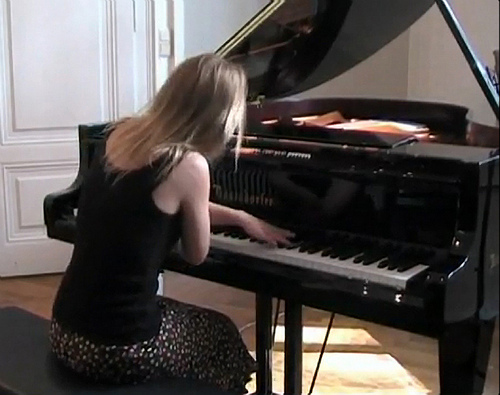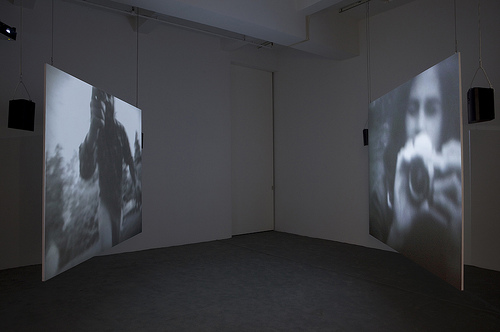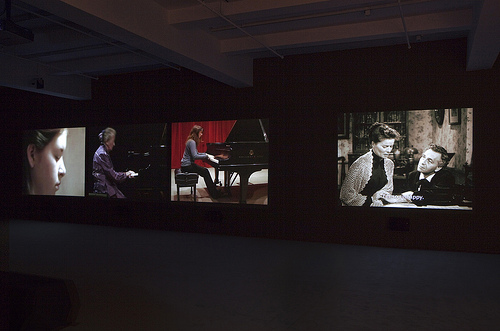10/12/11
Dara Birnbaum
South London Gallery
9 December 2011 – 12 February 2012
As someone who is notoriously sceptical about the extent to which video works ought to be considered art, Dara Birnbaum’s multi-channel installation, Arabesque (2011), being shown for the first time as the centrepiece of her solo exhibition at the South London Gallery, certainly convinced me of the possibilities. Born in New York in 1946, and trained initially in architecture and painting before becoming a pioneer in the burgeoning field of video art, Birnbaum’s works span over three and a half decades, from the early 1970s to the present day. Thus, whilst Arabesque amply fills the main gallery space, with its haunting soundtrack echoing through the corridors, bookshop, and café, it is put neatly in context alongside her oldest surviving installation, the black and white two channel work Attack Piece (1975), as well as eight small screen works from around the same time, all on display in the upper galleries.

Concerned with the relationship between the camera, the subject, and the viewer, as well as with gender stereotypes and women’s roles, her early works are a mixture of performance, politics, and psychological portraiture. Everything’s Gonna Be… (1976), for example, which is showing on a small monitor with its own headphones, presents a narrative about various US presidents and their affairs or encounters with girls, whilst, next door, six small screens run in parallel, Six Movements: Video Works from 1975, each a chapter on its own, and each a different length, some with sound, but none with headphones. With one long bench down the middle, and three screens on either side, the viewer becomes embroiled in the tension, distracted by the repeated scraping of a chair in Chaired Anxieties: Slewed, and the heavy breathing from Addendum: Autism, in which Birnbaum, performing her own work, rocks back and forth, eyes wide open and darting about in fear, paranoid, swallowing hard, panting, distressed, like a wild animal. On the opposite wall, in Control Piece, the movement is slower, but the exploratory hand creeping across the screen, the messy hair, and the psychiatric patient appearance are equally disturbing. Surrounded and entrapped, the viewer feels watched, unable to escape, unsettled to the extreme.

Attack Piece, as its title would suggest, is also fraught with tension. One screen shows slides, abruptly jolting and clicking through their sequence, whilst the opposing wall is filled with images from a handheld video camera, at times too blurry to make out, but mainly of Birnbaum herself, armed with a still camera, and filmed by her male collaborators (including David Askevold, Dan Graham, and Ian Murray). The whir of the motor and the motion sickness inducing jerkiness make it hard to watch, but the holiday snapshot set up, with 1970s clothes, hair, and cars, entice the viewer with an enrapturing fascination. I do wonder, however, quite how different my perception of this seminal work is from that of the contemporary 1975 audience.

For me, though, the real star of the show is Arabesque, and it would not be an exaggeration to say I could have sat there all day watching it over and over, being carried away on the melancholic chords of Clara Schumann’s Romanze 1, Opus 11, juxtaposed against her husband Robert’s better known Arabesque Opus 18. The screen on the right shows footage from the 1947 film about the couple, Song of Love, a melodramatic silent biopic about their relationship and her nursing him through his phases of depression and madness; the three left-hand screens show edited clips, taken from YouTube, of girls performing these works, overwritten with extracts from Clara’s diary, expressing her passion, grief, loneliness and feelings of inadequacy:
“… And I believe that a quieter life would leave me too much time for my grief…”
“… People fall in love with things they know in their heart they can never have…”
“… I need the love which beautifies daily life – if that were to go my life would go with it…”
“… Words always seem so feeble compared with what I feel. Feeling is so many-sided and words have but one side…”
But music and art achieve here what words alone cannot. The work explores and articulates the intensity of a range of relationships: between lovers, between a musician and his/her instrument, and with oneself. The passion these engender reverberates across the entire gallery, and accompanies the visitor for the rest of the day, stirring joy and pain, happiness and tears. If that doesn’t qualify it as art, I don’t know what does.

Images:
Arabesque (2011)
Film still of pianist Iris Weingartner from Arabesque (2011) taken with her permission from YouTube.
Courtesy the artist and Marian Goodman Gallery, New York – Paris
Addendum – Autism (1975)
From Six Movements – Video Works from 1975
Single channel video, black & white, mono, 7′ 20
Edition of 10
Courtesy the artist and Marian Goodman Gallery, New York – Paris
Attack Piece (1975)
Two channel video installation, black & white (transferred from film & slide footage)
2 mono audio, 7′ 40″
Courtesy the artist and Marian Goodman Gallery, New York – Paris
Photo: John Berens
Arabesque (2011)
Four channel video installation, four stereo audio, 6′ 30″
Courtesy the artist and Marian Goodman Gallery, New York – Paris
Photo: John Berens